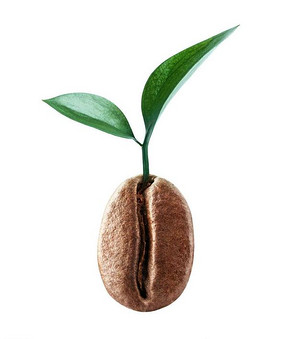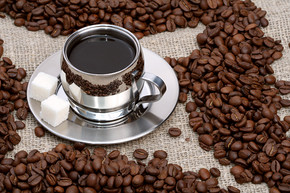Puerto Rican coffee is highly respected and loved by many coffee lovers.
The decline of Puerto Rico's coffee industry has a lot to do with its awkward economic and political situation. During the Spanish-American War, the United States had established a strong and lasting coffee trade agreement with Brazil, a coffee giant, and did not give too much thought to Puerto Rico, which had just been successful. Moreover, the economic purpose of the United States in the Caribbean is mainly focused on the sugar industry, which has made the local sugar cane production so booming that small-scale coffee retail investors have no way to fight, and coffee manufacturers who can survive have to merge again and again to retain their strength. It is said that the quality of local varieties has also been affected.
Nowadays, Puerto Rico's coffee is not even enough for domestic demand, and it still needs to import raw beans from other places for baking, so we don't know how much of the coffee we snapped up was picked on the island.
But the shortage of coffee on the island is not entirely due to the decline in production. Because of the closer relationship with the United States, few local people are willing to engage in the coffee-picking business. According to records, 1/4 of the coffee on the trees is wasted every year because it is not picked, because coffee farmers go to work in the United States. Those who stay, because of the minimum wage law, government subsidies, and other social welfare reasons, are also unwilling to do the work of bending over the slopes all day in the scorching sun. According to the latest statistics, today the population of the island is about 3.9 million, while the population of Puerto Rico in the United States reaches 4.2 million. No wonder the state government has recently been weighing the use of prisoners to pick coffee beans. It's just that no one knows how effective the work of these prisoners who prefer to stay in air-conditioned cells is.
Puerto Rico has the highest per capita GDP compared with Latin America as a whole, but it is lower than Mississippi, the poorest state, with 41 per cent of people living below the poverty line. But if it imports labor from other regions, it needs to pay a minimum federal wage and minimum health insurance, as well as stricter environmental policies. In this way, it loses its competitiveness compared with the surrounding Dominica, Jamaica, Cuba and other countries.

Coffee development in Puerto Rico
In 1736, the first coffee tree was introduced to Puerto Rico from Martinique. Since then, Puerto Rico has become the base for producing the highest quality coffee in the world. The unique taste chosen by Yaocote has also become the object of admiration of coffee experts all over the world. Most of the earliest coffee trees were planted by immigrants from Corsica. About 160 years later, the coffee industry in Puerto Rico has an extremely optimistic outlook, ranking sixth in the world in terms of total exports, and most of their coffee is shipped to Europe, including France, Italy and Spain. Coffee farms in Puerto Rico flourished until the 19th century, but unfortunately, the rise of sugarcane and drug farming and the effects of hurricanes and wars lagged Puerto Rico's coffee industry.
Today, Puerto Rican coffee is exported to all parts of the world. As the coffee in this country is generally carefully cultivated, it is pure, fragrant and granular, among which the best is among the world's famous brands. The best coffee is Yaocote (Yauco Selecto), which means "Selecto". Grand Lares Yauco is produced in the southwest of the island, while Lars coffee is produced in the south-central part of the island.
At present, Puerto Rico Yaoke Special Coffee has become one of the most famous coffee beans in the world. It is as famous as Kona coffee beans in Hawaii and Blue Mountain in Jamaica, and is highly respected and loved by many coffee lovers.
Puerto Rican coffee producing area
Puerto Rico, a small country in South America, is made up of a series of scattered islands, each season like spring, luxuriant flowers and plants, like a chain of beads scattered by God, you can see the brilliance of heaven at the slightest turn. Puerto Rico Yaoke's specialty coffee, grown on three farms in the southwest of the island, is fragrant and has a long aftertaste. This kind of coffee is very expensive and its flavor is comparable to that of any other coffee variety in the world. In the Yaoke area, the coffee is owned and operated by the local planter.
The mountain climate here is mild, the plants have a long mature period (from October to February), and the soil is of high quality clay. Some old varieties of Arabica coffee beans are grown here, although the yield is lower than other varieties, but generally of high quality. People here have been using an ecological and intensive planting method, using only some low-toxic fertilizers and chemicals, and taking mixed crop planting measures to make the soil more fertile. When it comes time to pick coffee beans, people walk back and forth between coffee trees, picking only fully ripe coffee beans, and then wash them in a roller device for 48 hours.
Puerto Rican coffee flavor
Any kind of coffee will be given a unique flavor because of its origin, just like different music styles will always give you different feelings. Yaoke coffee in Puerto Rico has all the characteristics of gourmet coffee, its acidity is very stable, full of particles, complete flavor, rich aroma. The reason why Yaocote chose coffee beans to be better than other producing areas on the island is that it is grown in high-altitude mountain areas, so it grows slowly and has rich fruit flavor, and it uses ancient coffee tree species, which have a unique flavor despite less yield. this is incomparable to some new tree species. Due to the abundant rainfall, rich soil and high-altitude microclimate zone, Yaoke coffee has all the qualities that gourmet coffee should have. Of course, Yaoke coffee is inseparable from the hard work of those coffee workers, who manage the whole process from planting coffee seedlings to post-harvest treatment.
Important Notice :
前街咖啡 FrontStreet Coffee has moved to new addredd:
FrontStreet Coffee Address: 315,Donghua East Road,GuangZhou
Tel:020 38364473
- Prev

Puerto Rico has a history of producing coffee for nearly 300 years. Why is it declining gradually?
Following Caf é (official Wechat account vdailycom) found that Puerto Rico, which has a history of producing coffee for nearly three hundred years, was one of the most productive regions in the world. Spanish explorers brought coffee from the French Louis XIV plantation to the island in 1736. The fame of Yao Konot's selection (Yaucono Selecto) was once with Kona and Kona of Hawaii
- Next

Guayama: the birthplace of Puerto Rican culture
Following Cafe (Wechat official account vdailycom) found that the Beautiful Cafe opened a small shop of its own, Guayama: Guayama, the birthplace of Puerto Rican culture, is located on the Caribbean coast, giving birth to many artists and musicians. Composer Catalino was born here. He wrote many famous songs and spread widely. In the 20th century, the African-American Andy Lano school
Related
- Detailed explanation of Jadeite planting Land in Panamanian Jadeite Manor introduction to the grading system of Jadeite competitive bidding, Red bid, Green bid and Rose Summer
- Story of Coffee planting in Brenka region of Costa Rica Stonehenge Manor anaerobic heavy honey treatment of flavor mouth
- What's on the barrel of Blue Mountain Coffee beans?
- Can American coffee also pull flowers? How to use hot American style to pull out a good-looking pattern?
- Can you make a cold extract with coffee beans? What is the right proportion for cold-extracted coffee formula?
- Indonesian PWN Gold Mandrine Coffee Origin Features Flavor How to Chong? Mandolin coffee is American.
- A brief introduction to the flavor characteristics of Brazilian yellow bourbon coffee beans
- What is the effect of different water quality on the flavor of cold-extracted coffee? What kind of water is best for brewing coffee?
- Why do you think of Rose Summer whenever you mention Panamanian coffee?
- Introduction to the characteristics of authentic blue mountain coffee bean producing areas? What is the CIB Coffee Authority in Jamaica?

